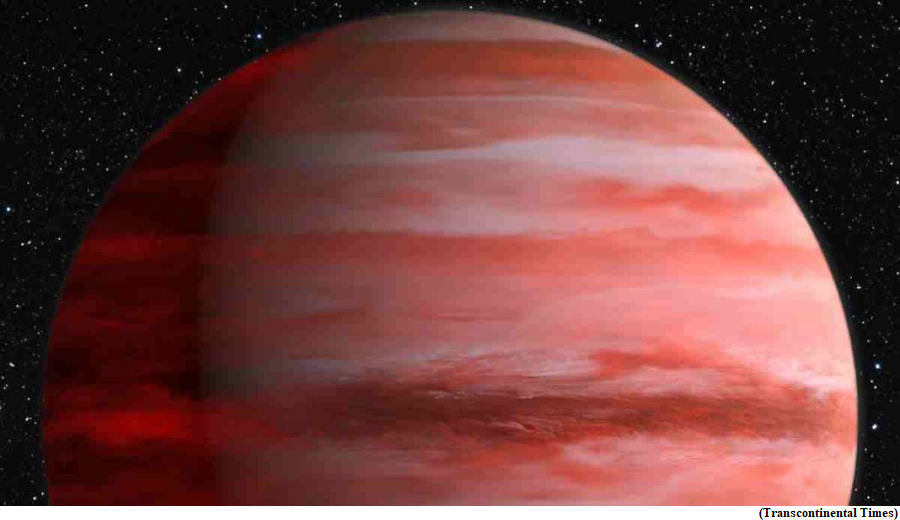Webb finds tiny quartz crystals present on exoplanet (GS Paper 3, Science and Technology)

Why in news?
- Researchers using NASA’s James Webb Space Telescope have detected quartz nanocrystals in the high-altitude clouds of WASP-17 b, a hot Jupiter exoplanet located 1,300 light-years from Earth.
- This marks the first time silica (SiO2) particles have been identified in an exoplanet atmosphere.
- They made this unexpected discovery while studying the atmospheric composition of WASP-17 b.
Why it matters?
- Silicates, minerals rich in silicon and oxygen, are common across the galaxy and form the bulk of Earth, the Moon, and other rocky objects in our solar system.
- However, the silicate grains previously detected in the atmospheres of exoplanets and brown dwarfs were typically magnesium-rich silicates like olivine and pyroxene, not pure SiO2 or quartz.
- This discovery challenges existing theories on how exoplanet clouds form and evolve.
How research was conducted?
- WASP-17 b, one of the largest and puffiest known exoplanets, was observed by the Webb telescope for nearly 10 hours.
- They collected over 1,275 brightness measurements of mid-infrared light as the planet crossed its star.
- An unexpected bump at 8.6 microns emerged in the data, a feature that would not be expected if the clouds were made of magnesium silicates or other possible high-temperature aerosols like aluminum oxide, but which aligns with the presence of quartz.
- The quartz crystals detected are similar in shape to the hexagonal prisms found in geodes on Earth, but each one is only about 10 nanometers across.
- Unlike mineral particles found in Earth's clouds, these quartz crystals originate in the atmosphere itself, forming directly from gas under the extreme conditions of WASP-17b's atmosphere.
- Understanding the composition of these clouds is crucial for understanding the planet as a whole. Hot Jupiters like WASP-17 b are primarily composed of hydrogen and helium, with small amounts of other gases like water vapor and carbon dioxide.
Way Forward:
- The discovery of silica crystals provides valuable insights into the inventory of different materials shaping the environment of this planet.
- The exact quantity of quartz and the extent of its distribution in the clouds remain uncertain. However, the researchers believe that the clouds likely circulate around the planet, vaporizing when they reach the hotter day side.
Amendment to Aircraft Rules, 1937
(GS Paper 3, Defence)
Why in news?
- Recently, the Ministry of Civil Aviation officially notified the amendment to Aircraft Rules, 1937.
- This is a significant step towards strengthening aviation safety and ease of doing business in aviation regulation with the amendment to the Aircraft Rules, 1937.

Details:
- These amendments align India’s aviation regulations with the International Civil Aviation Organization's (ICAO) Standards and Recommended Practices (SARPs) and international best practices.
- A portion of these reforms have been already notified with Amendment to the Aircraft (Demolition of Obstructions caused by Building and Trees, etc.) Rules, 1994.
Key Highlights:
- One of the key highlights of the Amendment to the Aircraft Rules, 1937 is the revision of Rule 39C.
- Under this amendment, the validity of licenses in relation to Airline Transport Pilot License (ATPL) and Commercial Pilot License (CPL) holders has been increased from five years to ten years.
- This change is expected to reduce administrative burden on pilots and aviation authorities like DGCA, promoting a more streamlined and efficient licensing process.
False lights:
- The Amendment to Aircraft Rules, 1937 introduces key changes under Rule 66, addressing concerns related to the display of "false lights" in the vicinity of an aerodrome. This update clarifies that the term "light" encompasses lantern lights, wish kites, and laser lights.
- The government's jurisdiction over those exhibiting such lights has been extended from 5 kilometres to 5 nautical miles around an aerodrome.
- Furthermore, it is made explicit that the government possesses the authority to take action against individuals displaying lights that disrupt the safe operation of aircraft or pose hazards to the operating crew.
- Should such lights remain unattended for 24 hours, the government is empowered to enter the location and extinguish them. Simultaneously, the matter shall be reported to the relevant police station for legal action under the Indian Penal Code (IPC).
- When the source of the observed light is unidentifiable or if it shifts locations, the airport or airline operator is obligated to promptly report the incident to the local police station, initiating potential criminal proceedings.
Other amendments:
- Rule 118 for validation of foreign licenses has been removed as being redundant. This change signifies aligning the regulations with the evolving needs of the aviation sector.
- Additionally, a clause to liberalise the recency and competency requirements while ensuring continued competence for Air Traffic Controller License holders has been added under Schedule III.
- This change offers increased flexibility to accommodate situations with limited movements or watch hours, Air Traffic Controller license holders must complete a minimum of ten hours of simulated exercises, including emergencies.
- Subsequently, they must undergo a skill assessment for their respective rating within ten consecutive days of commencing these exercises.
Way Forward:
- These amendments to the Aircraft Rules, 1937 represent a significant step towards strengthening aviation safety, security, and the ease of doing business within the aviation sector in India.
- These reforms will enhance the growth and sustainability of the aviation industry, ensuring it remains at the forefront of global aviation standards.
Magnetic-Stress as a new chauffeur of metal-insulator transition
(GS Paper 3, Science and Technology)
Why in news?
- The mystery behind the peculiar metal-insulator transition exhibited by certain materials under external stimuli such as temperature, pressure, electric fields has been decoded by scientists, paving the way towards designing functional materials and devices like sensors and actuators.

Transition ability:
- Materials primarily exist in one of the two fundamental electronic states: metallic or insulating. However, certain materials exhibit the remarkable ability to transition between these two states under external stimuli such as temperature, pressure, electric fields, and more.
- Since the initial discovery of this phenomenon in magnetite in 1939, the transition between the metal-insulator phases (MIT) has continued to captivate generations of scientists and engineers.
- Their foray into this area has offered critical scientific insights and applications in various devices and at the same time brought in the necessity of new materials that can exhibit metal-insulator phase transition for industrial applications.
- Chromium nitride (CrN) is an example of such a material, wherein the metal-insulator transition is anticipated to be instigated by an unconventional force arising from the anisotropic magnetic stress.
- However, the mechanism remained experimentally unverified even with the theoretical prediction for nearly two decades.
Latest research:
- A team from the Jawaharlal Nehru Centre for Advanced Scientific Research (JNCASR) has experimentally demonstrated that magnetic stress that stems from the peculiar arrangement of atomic spin drives the simultaneous structural, magnetic, and metal-insulator transition.
- They experimentally demonstrated the presence of magnetic stress as a driving force behind the metal-insulator transition in CrN and illuminated pathways for its manipulation.
- The magnetic stress within CrN emerges from the interplay between two distinct magnetic orderings along mutually perpendicular directions directly tied to the magnetic exchange interaction between two neighboring Cr atoms.
Key Highlights:
- They employed a technique that involves altering the equilibrium atomic spacing within CrN ultrathin films, to fine-tune the magnetic exchange interactions (epitaxial strain engineering).
- When subjected to compressive strain, the magnetic stress increases, resulting in metal-insulator transition at elevated temperatures compared to bulk values.
- Conversely, when the film is under tensile stress, the magnetic stress diminishes, prompting a metal-insulator transition at a significantly lower temperature than the bulk value.
- The structural symmetry also changes from rocksalt at high temperatures to orthorhombic at low temperatures simultaneously.
- Their observation affirms the pivotal role of magnetic stress in the metal-insulator transition of CrN.
Way Forward:
- The new mechanism of metal-insulator phase transition can lead to better understanding on how spin, charge and lattice degrees of freedom are coupled in materials and will also result in new classes of materials that exhibit metal-insulator phase transition.




